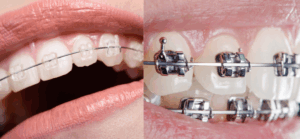Deciding on the right braces can feel personal and even emotional. I’ve seen teens dread the idea of bulky metal brackets, adults worry about how braces will affect their professional image, and parents wishing their child’s smile could transform without the constant reminder of braces.
That tug in your chest? It shows how much this matters. In this post, we will help you compare metal vs ceramic braces, explore types of braces, weigh the pros and cons of ceramic braces, and uncover which option—metal or ceramic—is best for teens, adults, and different orthodontic needs. Together, we’ll find the best choice for you.
Understanding the Difference Between Ceramic and Metal Braces
Metal braces use stainless steel brackets and wires, while ceramic braces have tooth-colored or clear brackets that blend in. Both systems apply the same pressure to move teeth, but the difference between ceramic and metal braces lies mainly in durability, cost, and visibility.
Pros and Cons of Ceramic Braces
Ceramic braces are much more discreet, offering a subtler look than metal. They’re less likely to irritate your gums and cheeks due to smoother brackets. However, they can stain (especially the elastics), are more fragile, and often cost more than metal braces. Removal can be tricky, occasionally causing enamel concerns if not handled gently.
Pros and Cons of Metal Braces
Metal braces remain the gold standard for serious orthodontic work. They are strong, durable, and usually the least expensive option. They may irritate cheeks briefly and are very visible, but for many, the customizable color bands can turn braces into a fun personal statement.
Which Braces Are Better for Adults?
If you’re an adult, you’re likely balancing image with results. Ceramic braces offer a more discreet appearance. Many adults ask, which braces are better for professional life? For mild to moderate corrections, ceramic may win. But for complex cases and maximum efficiency, metal braces often perform better—plus adult patients are embracing metal as a bold style choice these days.
Metal or Ceramic Braces for Teens?
Teens are in a unique spot. They want a treatment that works but also fits their social lives. Metal braces are sturdy and budget-friendly, ideal if they play sports or are active. Ceramic braces offer a more subtle look, but they can be bigger and require more cautious care, something to consider depending on lifestyle.
Types of Braces – Where Ceramic and Metal Fit In
Orthodontic treatment options include:
- Metal Braces: Time-tested, strong, colorful, and cost-effective.
- Ceramic Braces: Discreet and smooth, great if you want something less obvious.
- Lingual Braces: Hidden behind your teeth—expensive and possibly affecting speech.
- Clear Aligners: Removable trays like Invisalign—great for mild issues, but require strict wear and can be expensive.
- Self-ligating Braces: Metal or ceramic with low-friction clips—cleaner and faster for some cases.
Factors That Should Guide Your Decision
- Treatment Goals & Complexity: Metal handles tougher cases; ceramic is best for mild to moderate needs.
- Aesthetics & Lifestyle: If you’re concerned about appearance, ceramic or lingual braces are options—but they come with caveats.
- Oral Hygiene: Ceramic requires more care around brackets and elastics to prevent staining.
- Cost Differences: Ceramic typically costs 20–30% more than metal.
- Durability & Emergencies: Ceramic breaks more easily, possibly causing more visits.
- Comfort & Irritation: Ceramic is slightly gentler on cheeks; metal may cause short discomfort after adjustments.
- Age Factor: Adults may lean toward ceramic or lingual; teens often choose metal for resilience and cost.
Metal vs Ceramic Braces: A Side‑by‑Side Comparison
| Feature | Metal Braces | Ceramic Braces |
| Visibility | Very visible | Less visible, more discreet |
| Durability | Very strong | More fragile, can chip |
| Comfort | May irritate initially | Smoother on cheeks |
| Treatment Speed | Usually faster | Similar, sometimes slightly slower |
| Cost | Most affordable | 20–30% higher |
| Stain Risk | None | Elastic ties can discolor |
| Best For | Active kids/complex needs | Image-conscious teens & adults |
Choosing Based on Your Situation
Are you a teenager playing sports or a busy adult leading meetings? Do you mind the look of braces, or do you want the strongest, most cost-effective option? Your orthodontic treatment options should align with your lifestyle, budget, and smile goals. Ceramic may be perfect for someone social-facing; metal could be ideal for those needing robustness and affordability.
Final Takeaways
- The key difference between ceramic and metal braces lies in visibility, durability, cost, and comfort.
- Pros and cons of ceramic braces include improved appearance but higher cost, fragility, and risk of staining.
- Metal braces are strong, cost-efficient, and fast, ideal for active lifestyles and complex cases.
- Adults may value aesthetics; teens may choose metal for resilience and affordability.
- Compare types of braces within context: look, budget, age, and dental needs matter most.
- At Goldkind Family Orthodontics, we guide you through every orthodontic treatment option and help decide which braces are better for your life.
Get to Know the Goldkind Family Orthodontics Team!
At Goldkind Family Orthodontics in Morristown, NJ, we’re here to help you make the right choice between metal and ceramic braces. Whether you’re a parent exploring options for your child or an adult seeking a confident, healthier smile, our experienced team will guide you every step of the way. Call us at (973) 538-5067, visit us at 28 DeHart St., Morristown, NJ 07960, or schedule a consultation online. Let’s find the perfect orthodontic solution for your lifestyle, needs, and smile goals.

